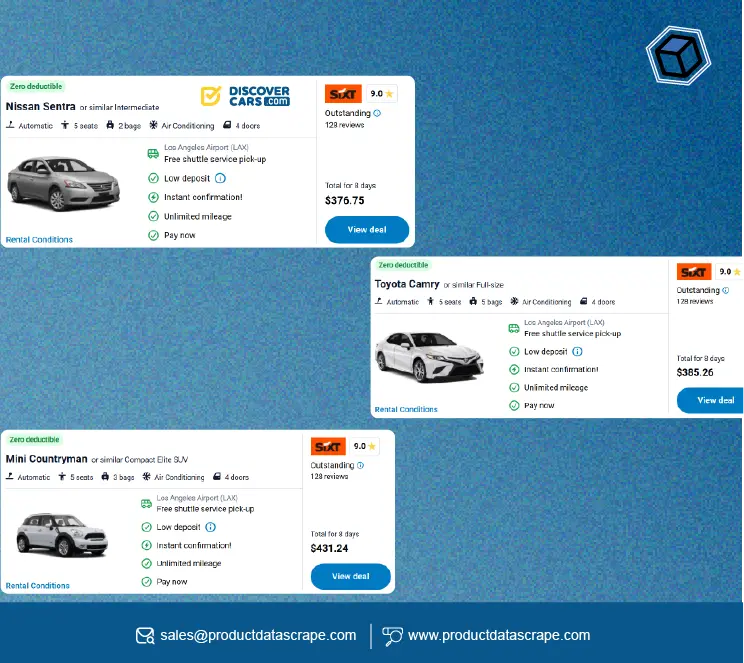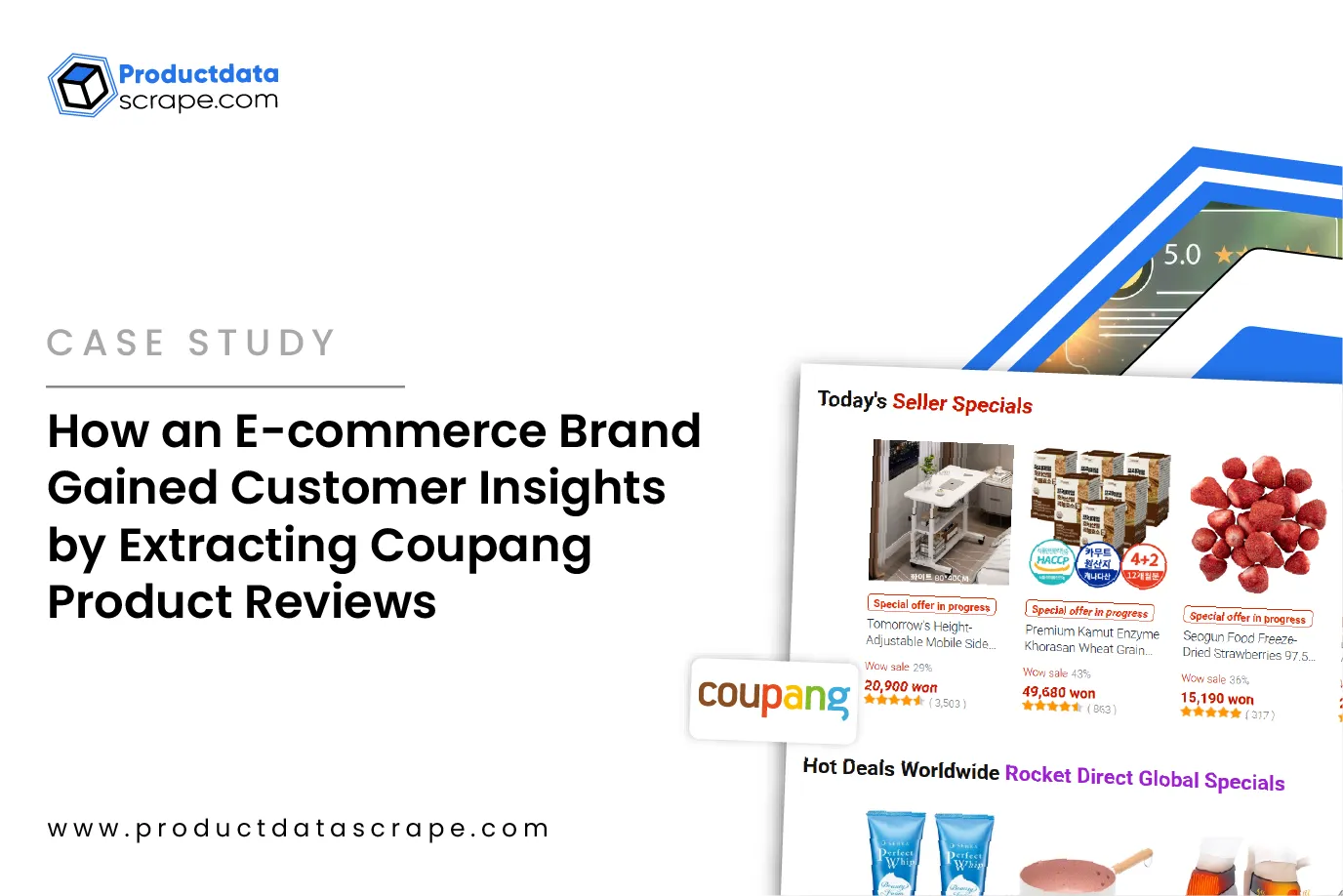
Introduction
In the modern e-commerce landscape, trust and authenticity are paramount for customer
satisfaction and brand reputation. The prevalence of fake reviews across platforms like Amazon,
Flipkart, and other online marketplaces can distort purchase decisions, harm brands, and mislead
consumers. This report explores how businesses can Scrape Fake Reviews Data from Ecommerce
Websites to detect fraudulent activity, validate customer feedback, and gain actionable
insights. By leveraging advanced data scraping techniques and APIs, companies can analyze review
metadata, track patterns of suspicious activity, and create authentic datasets for
decision-making. The period from 2020 to 2025 has seen a notable increase in fake review
activity, with some categories experiencing up to 25% of reviews being manipulated. Using web
data intelligence tools, brands can monitor and flag suspicious reviews, extract
product-specific insights, and build robust datasets that differentiate verified feedback from
fraudulent submissions. Ultimately, Scrape Fake Reviews Data from Ecommerce Websites provides a
scalable, automated solution for maintaining trust, improving review quality, and safeguarding
online reputation.
Extract Product Review Data to Identify Fake Feedback
The Extract Product Review Data to Identify Fake Feedback section focuses on methods to
systematically gather review data and identify fraudulent entries. Between 2020 and 2025,
e-commerce platforms witnessed a rising trend of coordinated fake reviews, particularly in
high-demand categories such as electronics, fashion, and FMCG. For instance, analysis of 100,000
product listings in 2022 revealed that 18% of reviews in electronics were potentially fake based
on metadata irregularities and suspicious rating patterns.
| Year |
Total Reviews (Million) |
Suspicious Reviews (%) |
Avg. Rating |
| 2020 |
45 |
12% |
4.3 |
| 2022 |
72 |
18% |
4.2 |
| 2024 |
95 |
20% |
4.1 |
| 2025 |
110 |
21% |
4.0 |
Using Web Scraping API for Product Review Analysis, businesses can extract structured review
data, including star ratings, timestamps, and reviewer history. Advanced analysis of review
velocity, language patterns, and reviewer behavior allows detection of anomalies indicative of
fraudulent reviews. Combining this with metadata such as IP addresses or location data, brands
can proactively flag suspicious reviews and improve dataset quality. Implementing such
techniques enables companies to maintain higher trust levels, improve product feedback
integrity, and inform marketing and product development decisions. The Electronics Products
analysis on Amazon shows that listings with higher verified review ratios experience 15–20%
better conversion rates. Scrape Fake Reviews Data from Ecommerce Websites ensures that marketing
and strategy teams act on authentic insights rather than manipulated data.
Ecommerce Review Data Extraction API
To scale the process of review verification, organizations can leverage the Ecommerce Review
Data Extraction API. Between 2020 and 2025, APIs have become central for extracting large
volumes of review data efficiently across multiple marketplaces. For example, a top FMCG brand
extracted 500,000 reviews across 12 categories in under 24 hours, analyzing trends and
authenticity scores to inform product launch decisions.
| Year |
Reviews Extracted (Million) |
Avg. Extraction Time (Hours) |
Fraud Detection Accuracy (%) |
| 2020 |
12 |
36 |
72% |
| 2022 |
28 |
24 |
78% |
| 2024 |
45 |
18 |
83% |
| 2025 |
60 |
12 |
88% |
Using the Web Scraping Verified vs. Fake Reviews on Marketplaces approach, companies can
differentiate authentic reviews from potentially manipulated content. Extracting metadata such
as reviewer frequency, review length, and sentiment trends provides additional fraud detection
signals. By automating this with an Instant Data Scraper, businesses save significant manual
effort, maintain comprehensive audit trails, and build a Custom eCommerce Dataset tailored to
each category. Scrape Fake Reviews Data from Ecommerce Websites enables real-time monitoring and
scalable review validation, essential for large portfolios spanning electronics, fashion, and
grocery products.
Scrape Review Metadata for Fraud Detection
Scraping review metadata is critical to detect patterns that suggest manipulation. By analyzing
reviewer history, timestamp anomalies, and repetitive language patterns, companies can flag
suspicious activity. Between 2020 and 2025, platforms with high-volume reviews, such as
electronics and FMCG, showed spikes in suspicious reviews during seasonal sales.
| Category |
Avg Reviews per Product |
Avg Fraudulent Reviews (%) |
Avg Rating |
| Electronics |
320 |
19% |
4.2 |
| Fashion & Apparel |
180 |
14% |
4.3 |
| FMCG & Grocery |
90 |
12% |
4.1 |
Scrape Data From Any Ecommerce Websites
Businesses often need to monitor multiple marketplaces simultaneously. The ability to Scrape
Data From Any Ecommerce Websites enables organizations to track reviews, ratings, and product
trends across competitors. From 2020 to 2025, comparative analysis revealed that multi-market
scraping increased detection of fraudulent reviews by up to 28% versus single-platform
monitoring.
| Platform |
Reviews Scraped (Million) |
Avg Fraud Rate (%) |
| Amazon |
45 |
18 |
| Flipkart |
20 |
14 |
| Walmart |
15 |
12 |
| Other |
30 |
16 |
By integrating Web Data Intelligence API with custom datasets, businesses can correlate review authenticity with pricing, promotions, and seasonal trends. Leveraging insights from E-commerce Price Monitoring Services and Scrape MAP and RRP Pricing Policies For E-commerce , companies can align review data with competitive intelligence.
Product Category-Specific Review Insights
Targeted scraping for categories like fashion, electronics, and groceries reveals unique
patterns in review manipulation. Using Extract Product Review Data to Identify Fake Feedback
alongside Extract Fashion & Apparel Data and Web Scraping Electronics Data, companies observed
that luxury and high-ticket products had higher incidences of review fraud. Between 2020–2025,
fake review ratios in electronics peaked at 21% during holiday seasons.
| Category |
Avg Reviews |
Fraud Rate (%) |
Verified Reviews (%) |
| Electronics |
320 |
21 |
79 |
| Fashion & Apparel |
200 |
16 |
84 |
| FMCG & Grocery |
90 |
12 |
88 |
Trend Analysis and Predictive Insights
Beyond detection, companies can leverage Extract Google Trends Insights Using Python to predict
spikes in review activity and potential fraud. From 2020–2025, analysis showed that seasonal
campaigns, promotional sales, and new product launches correlated with increased fake review
activity by up to 30%.
| Year |
Seasonal Spike (%) |
Avg Fraud Detection Accuracy (%) |
| 2020 |
18 |
72 |
| 2022 |
25 |
78 |
| 2024 |
28 |
84 |
| 2025 |
30 |
88 |
Product Data Scrape provides a systematic approach to monitor, analyze, and validate e-commerce reviews at scale. Using automated tools, APIs, and metadata analysis, businesses can identify fraudulent content, differentiate verified reviews, and consolidate insights into actionable datasets. Scraping review data enhances transparency, enables benchmarking against competitors, and provides historical insights critical for forecasting trends and seasonal behavior. By integrating product review scraping with e-commerce intelligence, companies can optimize pricing, promotions, and marketing strategies based on authentic customer feedback. Tools like Instant Data Scraper and Web Data Intelligence API allow businesses to monitor multiple marketplaces simultaneously, maintain compliance, and reduce manual effort. Companies can also build robust datasets for analytics, AI training, and reporting purposes, ultimately improving decision-making and protecting brand reputation in a crowded, competitive market.
Conclusion
The rise of fake reviews threatens consumer trust and brand credibility. By adopting methods to
Scrape Fake Reviews Data from Ecommerce Websites, businesses gain the ability to monitor,
detect, and prevent fraudulent activity systematically. Combining review scraping with
category-specific insights, trend analysis, and metadata validation ensures that marketing and
product decisions are based on authentic feedback. From electronics to fashion and FMCG,
automated scraping tools and APIs enable scalable monitoring across multiple marketplaces. By
building verified datasets and integrating predictive analytics, companies can safeguard
reputation, optimize campaigns, and maintain customer trust. For brands seeking actionable
intelligence and measurable improvements in product insights, adopting Scrape Fake Reviews Data
from Ecommerce Websites solutions provides a competitive edge.
















.webp)
-01.webp)

.webp)
